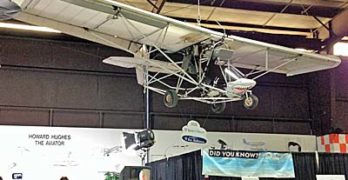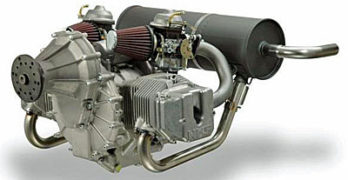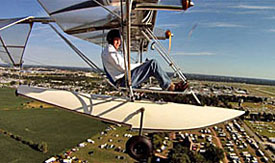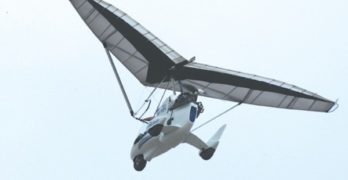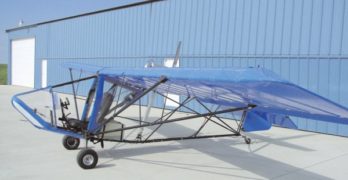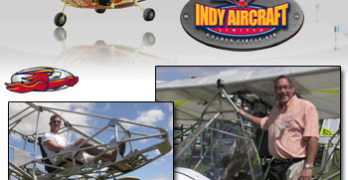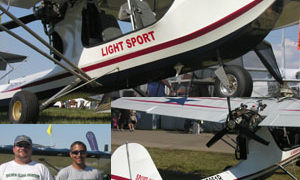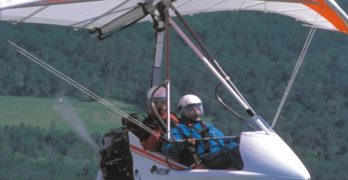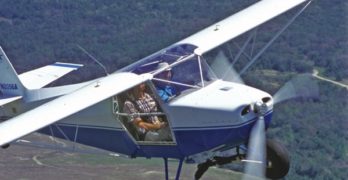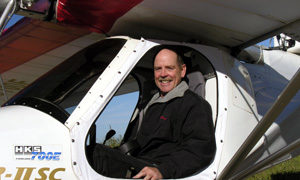Part 103 ultralight activity was not the news I expected to report from Sun ‘n Fun 2015, certainly not as my first report. After an intense week shooting video interviews at Sun ‘n Fun 2015, I am impressed to report that Part 103 is much more than alive and well. For those that may have missed this unique category, Part 103 ultralight vehicles (FAA’s deliberate wording) are single seat flying machines of varying description that need no medical, not even a pilot license, no N-number registration, and can be sold ready-to-fly. The entire FAA regulation for them can be printed on the front and back of a single piece of paper.
Adding to the charm of rarely having to interact with a government agency in order to have some fun in your airplane are a couple similar efforts in Europe. Germany has its 120-kilogram class (264 pounds) and England has its SSDR category (Single Seat De Regulated).
Search Results for : Four stroke and ultralight
Not finding exactly what you expected? Try our advanced search option.
Select a manufacturer to go straight to all our content about that manufacturer.
Select an aircraft model to go straight to all our content about that model.
HKS Four-Stroke Engine is Back on the Market
A majority of pilots express a preference for four-stroke engines due to their lower noise signature, reduced fuel consumption, ease of fueling and other reasons. For larger aircraft, engines from Rotax, Continental, and Jabiru may be preferred choices but for lighter aircraft most of these engines are more than needed (though the 80-hp Rotax 912 UL and 81-hp Jabiru 2200 can work for some intermediate-sized light aircraft). All the preceding engines are more costly as well. One popular, economical choice was the HKS from Japan but that well-regarded engine appeared destined to disappear from the American market, a shame as it is one of only a few engines to have successfully complied with the ASTM standards needed for use on LSA. No such FAA acceptance is needed for Part 103 ultralight vehicles or Experimental Amateur-Built aircraft. Fortunately, to paraphrase Mark Twain, “Reports of [the HKS] death were greatly exaggerated.”
Earlier in 2014, HKS discontinued production of HKS-700E and HKS-700T.
AirVenture 2011 Wrap-Up and Summary
Oshkosh 2011 is history. By numerous accounts, this was a vast improvement over 2010 when the comments commonly went, “Well, I had some interest (in my airplane) and I hope to sell one or two… maybe.” This year I had easily 30 conversations revealing either outright positive successful results or varyingly robust mood indicators such as, “Looks like aviation has life in it again.” I heard from sellers and customers and rarely had to solicit their opinions. *** A number of aircraft purveyors said they took cash deposits and wrote firm contracts. I estimate about 30 aircraft sales by this method. Companies like Icon, Flight Design, and Terrafugia sold a large number of future delivery positions (more than 50, more than 60, and “several,” respectively). *** Icon neared or crossed the 500-on-order point, partly by “testing elasticity” in the pre-order market by lowering the A5 seaplane deposit to $2,000 from $5,000.
All-American Revo Sets New Standard
Behold the Revo, a new benchmark in weight-shift trike design.
Look carefully and you’ll see the Revo is not like any weightshift
light-sport aircraft you’ve seen before. The Revo had to
surpass impressive work by larger, more established companies to leap
to the forefront. Any way you look at it, the Revo is simply extraordinary.
I’ve been lucky to fly many trikes over the years. Every few years, one
of the leading producers would make a remarkable step forward in the
design of these flying machines with changes that tended to be evolutionary,
not revolutionary. Among them, I cannot recall a clean sheet of
both carriage and wing debuted as a single aircraft.
Welcome to Revo from Evolution Trikes, an all-new, blazingly fast
American trike like none before it.
The more I examined the Revo and then flew with Larry Mednick of
Evolution (and Tampabay Aerosports), I realized even Air Création’s
beautiful Tanarg trike had been done one better.
T-Bird I and the Future
An Easy-Flying Ultralight
Let’s see. A single-seat plane that can be purchased as an ultralight,
assuming your engine selection doesn’t push it over Part
103’s weight limit, or built from a kit and registered as an
Experimental-class aircraft, or purchased as a light sport aircraft
once the manufacturer meets the ASTM certification. What’s a pilot to do?
That’s the conundrum facing T-Bird I shoppers. This single-seater can be
a Part 103-compliant ultralight when using a Rotax 277, still available on
the used-engine market, though no longer supplied from Rotax’s Austrian
factory. Few prospective owners would select this engine, yet a more powerful
engine would push the T-Bird I over the Part 103 weight limit. Does that
leave only the Experimental amateur-built kit
option?
The answer is no, and yes. To explain this apparent
contradiction, a kit-built T-Bird I with a larger
Rotax engine or the 60-hp HKS 700E engine could
still qualify under the 51% rule.
Ultralights Seek SLSA Approval; May Sell ELSA Kits
Taking a kit aircraft company to full ASTM approval is a very big decision for small companies. Simply assuring you have documents to support a declaration is, by itself, a major task. Then comes a decision about fully building or going the Experimental LSA kit route. A company must first fully build and certify at least one Special LSA, but once done, they can elect to provide a kit only…or to factory build and supply kits. Small shops could fully build 20-30 SLSA and supply additional ELSA kits and parts to make a healthy business. *** We may finally see such entries. Recently I wrote an updated pilot report on the T-Bird I from Indy Aircraft. Boss Bret Kivell said Indy is working on approval. As an ELSA, the single seater could be HKS (four-stroke) powered, which would make it one sweet sport aircraft. Likewise development is underway at Paul Mather’s M-Squared Aircraft where his Sport 1000 could gain SLSA approval later this year.
Old Becomes New…and Lowers the Cost of LSA
Sport Hornet is the second fixed wing “ultralight” to make the jump to Special Light-Sport Aircraft certification.* Some consider Hornet a “true ultralight” as it uses an aluminum tubing airframe. Builder Higher Class Aviation made numerous changes: The upside-down two-stroke Rotax 582 gave way to right-side-up four-stroke Rotax 9-series engines. Gross weight was increased. New dual struts brace dual wing spars. The cockpit is four inches wider and rear rudder pedals have more room. Conventional toe brakes are available. *** All these things are great but the best news may be base price for a reasonably well-equipped Sport Hornet with the 80-hp 912: $49,995. [UPDATE: 8/29/07 — HCA now gives buyers the 100-hp 912S for the same price!] And one more important thing: since Sport Hornet still flies like most ultralights it can continue to train pilots to fly other ultralight-type aircraft. After the final deadline of January 31, 2010, you’ll still be able to conduct training for hire in a Sport Hornet.
GT Ultralights: A Versatile Trike Supplier
Ukrainian airframe producer Aeros has risen from complete obscurity in the early 1990s (after the Berlin Wall fell) to wide recognition in recreational aviation. Although powered ultralight and light-sport aircraft enthusiasts may not immediately know the brand, hang glider pilots around the world are very aware of the name. The current reigning world champion hang glider pilot is Oleg Bondarchuck, a Ukrainian pilot who works with Aeros.
This young company emerging from the former Soviet mantel also makes an ultralight sailplane plus two powered aircraft. Aeros produces the Sky Ranger 3-axis airplane (under agreement with its French designer), and it has designed and markets its own trike. The company also supplies trike wings for other producers like Antares. By any normal measurements, Aeros is a versatile company.
Many ultralight and LSA pilots probably know the Aeros Velocity trike, and may recall its earlier name, Venture. In those days, it was sold by Sabre Aircraft alongside the trikes that Arizona company made here in America.
Just Aircraft’s Highlander
If you’re familiar with Avid Flyer or Kitfox aircraft, you know at least something about Just Aircraft’s Highlander. Its pedigree “path” is somewhat meandering but leads to an excellent flying machine born of a rich American airplane design heritage.
Dean Wilson was the originator of this now-proven design shape. The first departure from Wilson’s Avid Aircraft company was Dan Denney, who went on to offer the Kitfox. Denney’s prowess as a marketer brought international fame to the Kitfox and, over the years, the sale of nearly 3,000 aircraft. At one time Denney Aerocraft was among the country’s largest suppliers of kit-built aircraft. What had been an ultralight design evolved into a successful 2-seat homebuilt, but that wasn’t the end of the evolution behind Wilson’s original creation. Denney sold his company to Phil Reid, who renamed the Idaho company SkyStar.
A Well-Evolved History
Another break-off from Avid Aircraft and Denney Aerocraft was Flying K Enterprises, which introduced the single-seat Sky Raider.
Back in the Saddle in a Flightstar Ultralight
On a glorious fall day over the undulating hills of northeast Connecticut, I returned to flight after a five-month hiatus. Encouraged and accompanied by my old friend Tom Peghiny we enjoyed an hour sightseeing flight over the verdant countryside surrounding Tom’s Flightstar Sportplanes enterprise at the Woodstock airport. Gosh, it felt great to get back in the air! *** With the first revolution of the wheels I noticed how light the Flightstar seemed. I’ve done most of my flying in Light-Sport Aircraft lately and I guess I’d forgotten just how light ultralights can feel. We left the ground in a couple hundred feet lifted by a HKS 700E four stroke distributed by HPower. In an age of $100,000 LSA, this $25,000 Flightstar IISC certainly seems affordable to plenty of Americans. At 400 pounds less than LSA at gross, turns were pleasant low-gee maneuvers.
- « Previous Page
- 1
- 2
- 3
- 4
- 5
- …
- 17
- Next Page »


